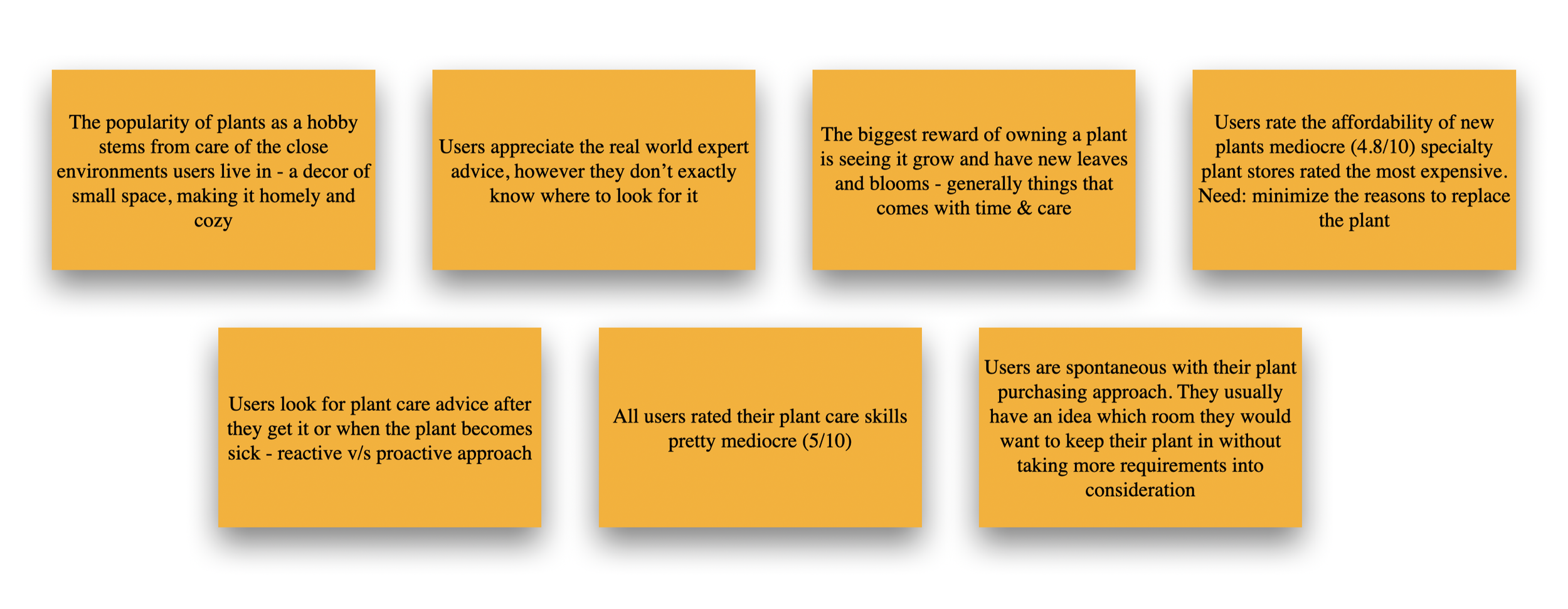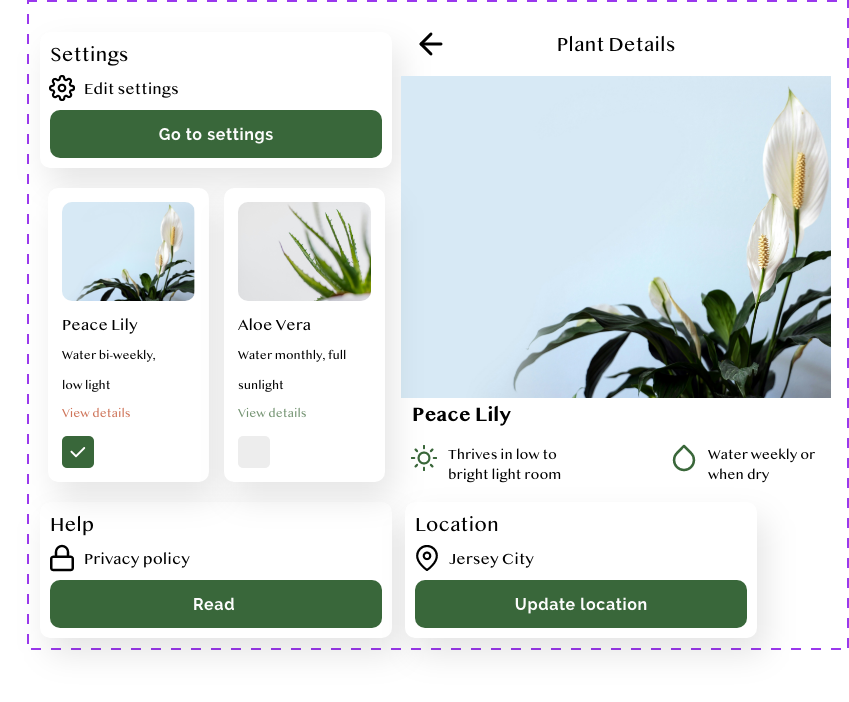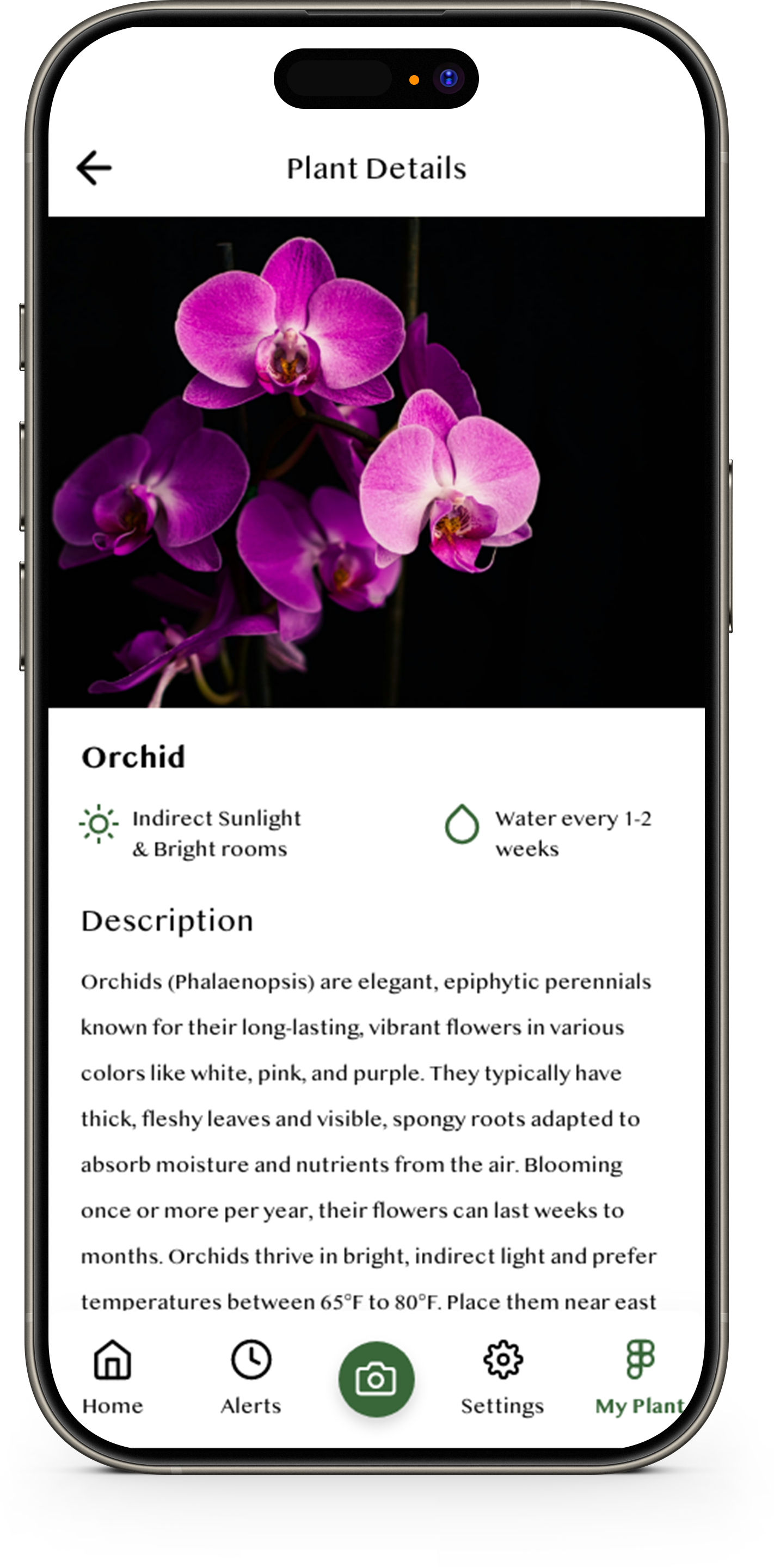
Plantwise.
About the product
Plantwise is your ultimate plant care companion, offering a holistic UX experience that allows you to easily scan and identify plants while providing tailored care tips to help them thrive. Whether you're a novice or an expert gardener, Plantwise offers instant access to detailed plant information through an intuitive and user-friendly interface, ensuring you grow with confidence and keep your greenery healthy and vibrant
Background
I started this project inspired by the growing local online plant exchange community, where plant enthusiasts connect and share their love for greenery. However, I noticed that the community operated in a very unstructured and chaotic manner, which often led to confusion and frustration. This observation motivated me to explore ways to make the experience more personalized and seamless for users, helping them achieve long-term success with their plant choices. Through my research, I discovered that one of the key issues was poor plant selection, largely driven by spontaneous and uninformed shopping decisions. This insight reinforced my commitment to developing a solution that would guide users in making better, more informed choices, ultimately enhancing their satisfaction and the health of their plants
Goals
Designing a comprehensive User Experience solution that delivers personalized plant recommendations based on individual preferences and local conditions, with the goal of enhancing user decision-making and reducing plant deterioration.
Problem
Choosing the right plants can be daunting, often leading to poor selections that result in plant deterioration and wasted money. Since plants flourish in specific environments, it's crucial to match them with the unique conditions of a home and the preferences of the owner. A significant part of the problem lies in the impulsive nature of plant shopping, which often leads to hasty, ill-informed decisions.
Problem Statement
How might we empower plant enthusiasts to make informed decisions by providing personalized plant recommendations that account for their preferences and local environmental conditions, ensuring healthier plants and more satisfying experiences?
Seconday Research
Impulse Buying
Research shows that consumers often make spontaneous purchases, especially in visually appealing environments like garden centers or online platforms. The lack of planning in these decisions often leads to mismatches between plant requirements and home conditions, resulting in plant deterioration.
Emotional Buying
Many people buy plants based on emotional appeal rather than practical considerations. They might be drawn to a plant’s appearance without understanding its care needs, leading to poor outcomes.
Knowledge Gap
A significant portion of plant owners lacks adequate knowledge about plant care, including light, water, and soil needs. This gap in knowledge often results in improper care and plant health issues.
Technology in Plant care
The use of technology, such as apps and AI, to provide plant care advice is on the rise. These tools can analyze local conditions (e.g., climate, indoor light levels) and user preferences to suggest the most suitable plants, leading to better care and satisfaction.
Shared Knowledge
Despite the chaotic nature of online plant exchange communities, they are rich sources of shared knowledge and experience. Structuring this knowledge into a more organized format can help users make more informed decisions.
Sustainable Living
As more people adopt plants for health and environmental reasons, there’s a growing need for tools that help ensure these plants thrive. Encouraging informed plant choices supports sustainability and reduces the environmental footprint.
Environmental Factors
Plants have specific needs that vary depending on environmental conditions such as light exposure, humidity, and temperature. A mismatch between plant needs and household conditions is a common reason for plant deterioration.
Overwhelming Choices
The sheer variety of plants available can be overwhelming for consumers, making it difficult to select the right plant without guidance.
Tailored Solutions
Personalized recommendations in e-commerce and retail settings have been shown to increase customer satisfaction and reduce return rates. In the context of plants, tailoring recommendations to the buyer’s home environment and lifestyle can significantly improve plant survival rates.
Peer Influence
Online communities and social media platforms play a significant role in influencing plant purchases. However, these recommendations are often based on personal experiences and may not be suitable for everyone, leading to mismatches.
Wasted Resources
Poor plant choices can lead to wasted money and resources, as plants that don’t thrive may need to be replaced frequently. This not only impacts personal finances but also contributes to environmental waste.
UX Case Studies
Successful apps in related fields (e.g., gardening apps, home improvement tools) often focus on user-centered design, providing intuitive interfaces, easy-to-understand guidance, and personalized recommendations. Incorporating these elements can make a plant app more effective and user-friendly.
Primary Research
Competitive Analysis
For this part of the project, I decided to explore top-rated plant care apps and compare their key features to identify the problems they address. I discovered that almost all of them provide basic plant care advice that users can access after purchasing a plant, often requiring premium access for more detailed information.
However, none of the apps offer substantial free content to help users grow their plant collection, engage in plant exchange communities, or receive advice during the purchase or research phase. To set my users up for long-term success, I realized that addressing problems occurring before the purchasing decision is crucial. Synthesized data from user interviews confirmed this assumption.
Define
PURCHASE TRIGGER
Jessica was out running errands and stopped by her neighborhood plant store. Recently, beautiful calatheas were popping up on her social media feeds and she is tempted to get one right when she's at the store.
User Persona
To better understand our target audience, I developed user personas based on research and interviews. These personas represent typical users, their goals, behaviors, and pain points. For example, one persona, "Jessica the Aspiring Gardener," is a working professional who loves plants but often struggles with choosing the right ones and keeping them healthy. She desires an easy-to-use app that provides comprehensive plant care guidance and supports her in making informed purchase decisions.
User Scenario
After developing my persona, I envisioned a specific scenario where she would interact with the product. This use case was shaped by insights gained from user interviews, competitive analysis that highlighted a gap in the market, and a deep understanding of the persona’s needs and challenges.
The Minimum Viable Product (MVP) is designed to empower users to make informed decisions before purchasing a plant. By matching plants with the user’s specific needs and environmental conditions, the product aims to ensure long-term success and satisfaction. It also helps users avoid impulsive, poorly thought-out purchases, ultimately saving them money and reducing the risk of plant deterioration.
EPIC
As a Plantwise user, I need to access the platform so I can successfully find the plants that will fit my space.
USER STORY
As a Plantwise user, I need to input the site criteria and other requirements that will allow me to match the plants available at the store with existing sites at my home.
As a Plantwise user, I need to scan the plant I like to see if it's a good match with my needs
SECOND THOUGHTS
Jessica remembers the last time she purchased a beautiful plant without checking the details of its requirements.
She doesn't want to repeat that mistake.
ACCEPTANCE CRITERIA
Ensure that the Plantwise user can:
successfully follow through with the onboarding process
enter the plant match parameters for available sites
Ensure that the Plantwise user can:
log in to Plantwise
Access the camera feature
Scan the plant
IS THIS A GOOD MATCH
Jessica remembers the last time she purchased a beautiful plant without checking the details of its requirements.
She doesn't want to repeat that mistake.
Ideation
Feature Prioritization
After identifying the solution that would deliver the most value to my users, I moved forward by brainstorming potential features for the app. My goal is to create an intuitive, on-the-go experience that is particularly user-friendly while shopping. This means prioritizing a simple interface, streamlined onboarding, and quick access to the core feature. The insights gathered from my research enabled me to clearly differentiate between features that offer high versus low value to users, allowing me to focus on the most impactful elements first
Information Architecture
To ensure a seamless and intuitive user experience, I developed a detailed information architecture for the app. This structure organizes content logically, making it easy for users to navigate and find the information they need. The main sections include "Plant Scanner," "Home page," "My plants," "Alerts," and "Settings."
Low Fidelity Mock up
Typography
Colors
Grid system
Gurmukhi's elegant and traditional style perfectly complements the app's refined and sophisticated interface. The font's versatility and readability ensure that all text elements, from headings to body text, are easily legible and visually appealing.
Components & Icons
Columns 4
Margin 16
Gutter 20
Width 85
The grid consist of 4 columns,16 margins, 20 gutter and 85 width
Green signifies growth, nature, and well-being, perfectly aligning with the app's dedication to plant care and nurturing
Black adds contrast and elegance, enhancing the interface's visual appeal and making it easy to navigate.
White delivers a pristine, minimalist backdrop, contributing to a sleek and contemporary look.
A grid system guarantees a consistent, responsive, and visually attractive layout across various screen sizes.
Visual Design
Onboarding Page
Login Page
Home Page
Search & Scan
My plant
Settings
The onboarding pages smoothly guide users through profile setup, add location, and preference customization, ensuring an effortless introduction to the app
The login pages provide a seamless and secure user experience, featuring quick sign-in options and straightforward account creation
The home page offers an overview of the user's plant collection, upcoming care tasks, and quick access to essential features for efficient plant management
By entering keywords, users can quickly find plants, articles, and care tips, enhancing their ability to efficiently access relevant information
The 'My Plant' page showcases the user's plant collection, while the 'Add Plants' page facilitates the easy addition of new plants
The profile page allows users to manage their information, preferences, and app settings for a personalized experience
























































